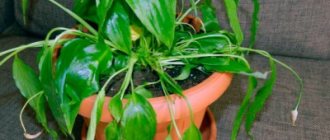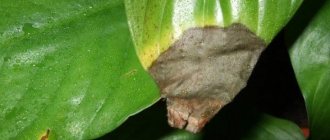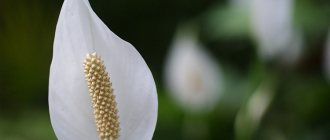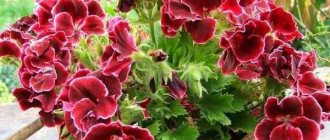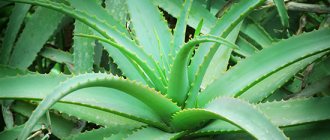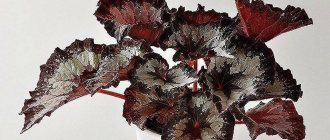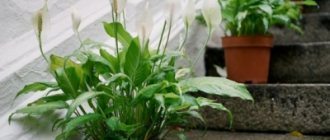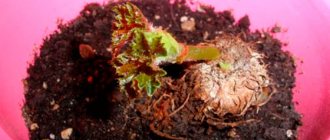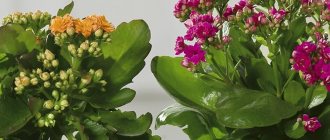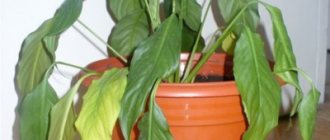How to take a shoot from a money tree
An adult money tree has a dense crown with many shoots. Any shoot separated from the mother plant can give rise to a new specimen. Therefore, finding material for rooting will not be difficult.
You can separate shoots at any time of the year. The easiest way is to prepare cuttings from shoots removed during routine pruning.
But you can tear off a shoot from the money tree and any cutting you like; they take root most quickly in spring and summer. However, you can root a money tree shoot in the fall and even winter. In this case, there is usually no need to use drugs to enhance root growth.
Cuttings are prepared from powerful and well-developed tree branches.
Thin and elongated shoots should not be used for this purpose. Any shoot will take root and begin to grow. But a weak shoot will give rise to a weakened plant, which, even with good care, will take a long time to recover.
Rules for preparing planting material
Even a beginner who has never done this before can master the process of reproduction of the fat woman. The plant takes root well even with minimal conditions. The culture is propagated by cuttings and leaf blades. In home gardening, most often - cuttings.
To get new growing trees you need:
- Use a developed cutting taken from a healthy plant.
- Place the planting material in a glass of water for 24-48 hours.
- Plant in pre-prepared soil.
How to take a shoot from a money tree? Choose any branch - all cuttings take root well without much hassle. For example, old specimens have shoots with small aerial roots. Having broken a shoot with leaves and roots, you don’t have to worry about how to grow a money tree from a twig. The root, as soon as it senses fertile soil, will quickly begin its development.
Soil preparation
Crassula is a succulent, and therefore requires appropriate soil. Substrate can be purchased at a garden center.
When preparing the soil yourself, mix:
- 3 parts river sand.
- 2 parts peat.
- 2 parts leaf soil,
- A handful of vermiculite or perlite.
Advice ! Before planting seedlings, it is recommended to sterilize the soil in the oven or microwave.
Choosing a pot
Since the plant is characterized by rapid development, choose a spacious pot for growing. The best option is a heavy and deep container with a stable base.
It is also advisable to use small pots, and as the bush grows, transfer it to spacious flowerpots. Although this method of transplantation is not recommended by professionals, many gardeners use it to grow Crassula.
Planting dates and technology
With proper care, a money tree grows very quickly, because the science of how to plant a shoot is only part of agricultural technology.
The planting procedure includes:
- Choosing a pot (it is best to take a heavy clay container).
- Place a layer of drainage material on the bottom of the pot.
- Laying prepared soil on drainage.
- Making a recess (using a regular pencil).
- Digging a cutting or shoot into a recess.
Pot and soil for growing young crassula
A pot made of any material is suitable for growing young crassula. But it grows and develops best in ceramic containers. This material provides oxygen access to the roots of the plant, and also promotes uniform drying of the earthen clod.
Ceramic pots are also chosen to ensure the stability of the tree. The fat plant, growing, quickly increases its green mass. Soon its crown becomes heavy. In order for the plant to stand firmly, it needs a massive clay pot.
The shape of the pot is very important for this succulent plant. You cannot choose a high pot for the tree, as moisture can stagnate at the bottom. The diameter of the pot should be no less than its height so that the soil in it dries well.
The dimensions of the money tree pot must correspond to the dimensions of its root system so that the roots fit freely in it. Do not plant a tree in a pot that is too large. Land that is not reclaimed by roots quickly turns sour, which leads to root rot.
Suitable soil for planting Crassula is suitable for succulent plants and cacti. If you want to mix the soil with your own hands, you need to take the following ingredients:
- Sod land - 4 parts;
- Humus – 1 part;
- Leaf soil - 1 part;
- Sand - 1 part.
Division of rhizomatous plants, separation of shoots
Dividing the bush and separating the shoots is the easiest way to propagate indoor plants.
This allows you to rejuvenate a plant that has become cramped in a pot and get a plant with roots, one or two stems or a rosette of leaves. By dividing during transplantation, you can propagate most rhizomatous plants that have strongly overgrown rhizomes underground and which have several buds. The part to be separated must have a bud and roots. Aspidistra, chlorophytum, sansevieria, primrose, bluebells, cyperus, arrowroot, bamboos, orchids, ferns, asparagus, etc. reproduce well in this way.
Division is a vegetative method of plant propagation. From a large bush, shoots are separated, each with several stems or rosettes, preferably with roots. The young plant begins to grow quickly and you will soon have a beautiful plant, more developed than those obtained from seeds or cuttings. It is best to divide in late winter or early spring, when the plants begin their growth period. Wait until the end of flowering if you want to divide the flowering plant.
How to properly plant a money tree shoot
There are 2 ways to plant a Crassula shoot. Sometimes a money tree shoot is immediately planted in the ground, where it takes root and then grows. But more often the cuttings are rooted in water, and after the shoot gives roots, the money tree must be transplanted into a pot with earthen soil.
If you decide to plant a money tree shoot without roots, then take a cutting about 10 cm long for rooting in the ground. Before planting, the freshly cut cutting must be dried for several hours. After this, its lower cut is buried in a pot with soil mixture to a depth of 3-4 cm.
Drainage at the bottom of such a pot is required so that the water does not stagnate after watering.
The handle should be in a vertical position, not tilted. It is not covered with film or a jar, since rooting does not require high humidity. The shoot is watered regularly, but very carefully. The soil should be only slightly moist after watering. Watering should not be carried out until the top layer of soil is dry. After the roots appear, the cutting begins to grow and forms new leaves.
You can root a money tree shoot in water. To do this, its lower cut is dipped in boiled water at room temperature. The cutting is kept in water until roots at least 5 cm long form on it.
After the roots have formed, the shoot is planted in a small pot with an earthen mixture.
It is necessary to lay a drainage layer of expanded clay at the bottom of the pot to drain excess water after watering. The shoot with roots is placed in the middle of the pot, and then the root system is covered with soil. The soil is slightly compacted, and the young plant is watered.
How to grow a money tree at home - planting and care instructions
The money tree is a plant belonging to the Crassulaceae family, named for the shape of its leaves. Other common names are Crassula and Crassula.
Methods of propagation of the beautiful Crassula
Growing a homemade money tree yourself is very simple, even for a novice gardener. This can be done in several ways.
With the help of a shoot . Rooting of a Crassula cutting occurs quite quickly.
Rooting in water:
- A cutting 7-10 cm long is placed in a container of water, removing about 3 cm of leaves from the bottom.
- You can add rooting stimulants to the water, for example, kornevin, but this is not at all necessary, since without any additives the cuttings will take root in about a week.
- The resulting shoot is planted in the ground.
Plant the shoot directly into the ground:
- The base is buried 2-3 cm into the ground for cacti or succulents, sprayed with water and, if necessary, a support is installed.
- The pot is chosen to be small in size and a layer of drainage is placed on the bottom.
- Roots appear quickly, within 1-2 weeks.
Using a sheet . A money tree is grown from a leaf using the same methods as from a cutting. First, I root the leaf in water, then plant it in the ground, or immediately plant the leaf in the ground and wait for young shoots. The principle is the same as when growing violets from a leaf.
Conditions and rules for growing fat plants
In order for the money tree, according to popular belief, to bring profit and improve financial well-being, it must be properly cared for. After all, as legends say, only a healthy, powerful and properly formed plant has magical properties.
Ideal soil and the right pot
The best soil for Crassula is suitable for cacti and succulents. If a universal mixture is used, then part of the river sand is added to it in a ratio of 3:1. If the soil is acidic, then dolomite flour is added to it - Crassula does not grow well in an acidic environment.
The pot should be low and wide. Select the size of the pot based on the size of the plant. The diameter of the pot should be approximately equal to the diameter of the crown. The money tree grows equally well in clay and ceramic dishes, as well as in plastic pots. Be sure to add a few centimeters of drainage to the bottom of the container.
Location and regular care
The fat woman prefers a bright and warm place. The eastern side is ideal for growing it , but the western and southern sides are acceptable. When grown on a southern windowsill, the tree must be shaded from the scorching rays of the sun.
Every 2-3 weeks the pot should be rotated on 1/4 axis towards the light source. It is necessary to protect the plant from drafts. They can cause leaves to fall. By the way, the toast is recommended as a plant for the bedroom; it is believed that its presence improves the relationship between spouses.
The money tree should be watered regularly and abundantly. The earthen clod should not be allowed to dry out more than 2-3 cm. The water should be at room temperature. In winter, watering is slightly reduced.
Feed the fat plant with universal fertilizer or fertilizer for cacti and succulents. The frequency of fertilizing during the spring-summer growing season is once every 2-3 weeks. The rest of the time, fertilizers are not used.
Crown formation and wintering
To grow a thick money tree , you need to plant it in a small pot. When the entire earthen ball is entwined with roots, the fat plant will begin to increase the mass of the trunk, and then the crown.
In order to stimulate the formation of a lush crown , pinching begins already when the young plant has a bud above four pairs of leaves. It is pinched so that after some time two shoots form in its place, which, in turn, are pinched in a similar pattern.
Crassula does not have a pronounced period of rest. However, from October to February-March, it is advisable to keep the plant in a cooler place, approximately 15-20 degrees. Watering is carried out when the earthen clod is half dry.
Dangerous diseases and pests
The most common cause of Crassula disease is spider mites . In this case, the trunk, branches and leaves are covered with a white coating of cobwebs. A soap solution will help get rid of it. A soft sponge is moistened with soap dissolved in water and wiped all areas of the plant. In case of severe damage, it is worth using the drug "Fufanon".
If brown or rusty spots appear on the leaves of the money tree, then we can conclude that it is infected with scale insects . The affected areas are wiped with a brush dipped in alcohol, then, as in the case of spider mites, the leaves, branches and trunk are wiped with a sponge dipped in a soap solution. It is recommended to use "Fufanon" or "Fitoverm" among the drugs.
White flakes in the leaf axils indicate mealybug . In this case, the plant slows down its growth, the shoots become deformed, and the leaves may fall off. If the lesions are small, then foreign formations are cleaned off with a brush. If a significant part of the plant is affected, then it is necessary to use actellik for treatment.
If the leaves have lost turgor, become lethargic and yellow, then there may be several reasons:
- One of the most common is insufficient watering. The pot is placed in a container with warm, settled water for 15 minutes, then the excess moisture is allowed to drain.
- The second reason is decay. The leaves become wet. The plant is taken out of the pot, the soil is shaken off, the roots are inspected and damaged ones are removed. The cut areas are sprinkled with crushed coal. Plant the tree in fresh soil and reduce watering for a while.
- Long exposure to direct sunlight can cause leaves to yellow and fall off. To prevent this, the pot with the plant is removed to the back of the room and sufficient watering is provided.
In the warm season, the money tree can be kept in the fresh air - used for a garden on a balcony or in landscape gardening. It is important to ensure that the air temperature does not fall below 15 degrees and not leave the plant in the rain.
Home gardening expert Nastasya Vorob spoke about how to properly grow a money tree from a shoot or leaf. Tips for proper care of house plants are waiting for you in this section.
How to care for an adult tree crassula
Caring for an adult tree crassula differs little from caring for a rooted shoot. Particular attention should be paid to:
- Content temperature. The optimal temperature for Crassula in summer is in the range of 20-25ºС. In winter, the temperature is lowered to 12-16ºС to organize a dormant period. For young trees, unlike adults, in the first winter of life it is better not to reduce the temperature, but to care for them in the same way as in summer;
- Lighting. Mature money trees are not afraid of direct sun. Its rays can fall on their leaves without causing harm. And in the morning and evening hours this is very useful, since bright lighting promotes proper growth and the formation of a lush and uniform crown. If there is no well-lit place for the tree, it can be kept in diffused lighting. It is important that it does not remain in the shade, where the branches stretch and weaken over time;
- Watering mode. Unlike young rooted cuttings, an adult fat plant requires rare watering, between which the soil in the pot should dry out almost completely. Moist soil should remain only inside the earthen ball. Any stagnation of water causes the development of root rot, which quickly destroys the plant. Therefore, water the fat plant little by little and only after the earthen lump in the pot has dried out by 3-4 cm;
- Feeding. This plant, like most succulents, is adapted to life in depleted soils. It should be fed less often than other indoor plants. During the active growing season, fertilizing is carried out monthly. From mid-autumn until spring, feeding is stopped. Use compositions for cacti and succulents;
- Plant pruning. Prune the plant in the spring before active growth begins. During this period, hygienic pruning is combined with formative pruning. After wintering, cut out all weak and elongated branches. Dry and damaged shoots and leaves are also removed. Then they begin to form the crown. By pruning, the crown of the plant can be given any shape. Branches that are too long are shortened by 1/3. Powerful, unbranched shoots are slightly shortened so that they begin to branch.
Stem cuttings and leaves
The most common method that can be used all year round. It is suitable for most indoor plants.
- choose a strong, healthy, non-flowering shoot (the cutting must be at least 7 cm long) or a strong leaf.
- cut it with a blade or a sharp knife: the stem is below the leaf node, the leaf is strictly across.
- place in soil.
Cactus cuttings, as well as large leaves of succulents (crassula, sedum), must first be dried for several days before planting so that they do not rot in the pot.
Plants: violet, gloxinia, cacti and other succulents; Begonia, tradescantia, ivy, and impatiens will easily take root even in a glass of water.
Secrets of success
- Always plant several cuttings at a time and don't be discouraged if some don't take root.
- Almost all cuttings (with the exception of cacti, succulents and geraniums) need moist air, so it is better to cover the pot with the cutting with plastic.
- The pot should be kept in the shade, avoid direct sunlight.
- The temperature should not be lower than +18°C.
Houseplant propagation
There are 3 ways to propagate this popular plant:
- Sowing seeds. Crassula seeds are practically not propagated in apartment conditions. This plant blooms extremely rarely. But even if you manage to get seeds, it will take several years to grow a tree. This method is very painstaking and time-consuming. It is much easier and faster to obtain a young plant using one of the vegetative propagation methods - cuttings or propagation by leaf blades;
- Cuttings. The most common method of propagating Crassula in indoor culture is cuttings. The cuttings can be cut from any adult specimen. It takes root equally well in soil and water. There are no special techniques for rooting cuttings. They take root at any time of the year, and 100% of the prepared shoots take root. The best are considered to be cuttings on which aerial roots have already formed. They take root even faster;
- Leaf propagation. You can get a young fat plant by rooting a leaf blade. To do this, you need to separate the leaf from the shoot and bury its base in a pot of soil. In moist soil, it will eventually take root, and then at its base, children will form, from which new plants will grow. The leaf should not be too young, nor should it be old, damaged or yellowed. It should be noted that a young specimen grows from a leaf much longer than from a cutting.
Features of Crassula propagation by cuttings
Crassula can be grown from a shoot. The flower takes root easily. Any time of the year is suitable for reproduction. Early spring is the most favorable period.
The Crassula is of South African origin. In its homeland it grows and blooms in the wild. At home, the tree rarely blooms.
- To obtain a cutting of a plant such as Crassula, you need to take a twig from a healthy plant that has lignified shoots with shoots. The cutting is a blank, and it should be without signs of damage or disease, 6-10 cm long and have 4 - 5 leaves. A healthy indoor flower will grow from a healthy harvest.
- The cut site and the sprout itself must be treated with activated carbon powder to avoid infection.
- To grow roots, the sprout must be placed in water or soil. In water and in soil, the regrowth time is approximately the same - 10 days.
Transplanting a money tree
Crassula is replanted in the spring. This procedure is carried out before the start of active growing season. The best time to transplant is mid or late March. Young fat plants need to be replanted annually in fresh soil.
Before transplanting, you need to purchase a pot whose diameter is 1-1.5 cm larger than the previous one. A drainage layer of expanded clay or broken brick, at least 3 cm thick, is placed on its bottom. The drainage holes located at the bottom of the pot are covered with pebbles or shards.
A layer of soil 0.5-1 cm thick is poured on top so that the roots of the plant do not touch the drainage. Then the fat plant is removed from the pot along with a lump of earth and placed in a new pot. The fat plant is transplanted by transshipment so that its root system suffers as little as possible.
The space on the sides of the earthen ball is filled with fresh soil. It is compacted using a thin stick or pencil. After transplantation, the plant is not watered for several days so that the damaged roots can dry out.
After this, the normal watering regime is gradually resumed. It is advisable to move the tree to partial shade for 1-2 weeks after transplanting. Adult fatworts after 5 years of age are transplanted less frequently. For them, this procedure is carried out every 3-4 years.
How to plant ficus using air layering
To do this you need to do the following:
How to plant ficus using air layering photo
- a cut is made on the tree-like stem at an angle of 45°;
- a sliver or match is inserted into it, this is necessary so that the cut does not become overgrown and sealed with milky juice;
- Fix wet moss around the cut and cover it with polyethylene, fix it all securely.
Over the course of a month, the moss must be periodically opened and moistened; as soon as roots appear in the form of air layering, the top can be cut off and planted in a separate pot. It is recommended to carry out this procedure in early spring, when the plant begins to grow intensively. The cut must be treated with crushed charcoal.
How to grow roots on a cake?
In order for the sprout to quickly gain strength and become capable of independent life, you need to build up the root system:
- To do this, you can use biostimulants such as heteroauxin and root.
- If you are against artificial stimulants, replace them with natural ingredients, which include aloe juice or a water solution of honey.
- Sphagnum moss also helps accelerate root growth. It needs to be soaked in any of the listed stimulants, then squeeze out the moisture and attach it to the neck of a young plant with a thread. Every day the moss is moistened with a spray bottle.
A year after transplantation, the young plant needs to be transplanted into a spacious container and cared for as an adult flower. But the sprout will be considered a full-fledged orchid no sooner than in two to three years.
Getting a baby from an orchid is not as easy as it might seem. The most important thing is to follow the rules, and then new shoots will not be slow to appear.
FAQ
Why replant the plant every year?
This must be done so that the plant blooms profusely in the summer. In this case, the pot must be exactly the size of the spathiphyllum root system.
Why remove dead parts of the plant when dividing the rhizome?
They are removed because there may be infections in their sinuses and this will be visible when removed. Also, when they decompose, they can cause harm to the plant, and what is important is the appearance of the plant. Decomposed and dry parts of the leaves will not add beauty to it.
What do the brown edges of the spathiphyllum leaf mass indicate?
This indicates that the air in the room is very dry. This can be corrected by placing the container with the plant in a wide tray on expanded clay. The brown tips will not turn green, but it will stop them from appearing en masse on the bush.
